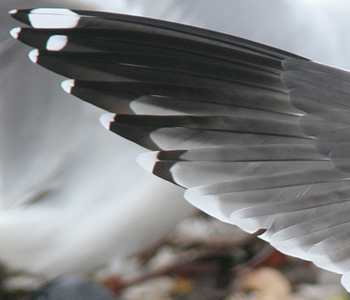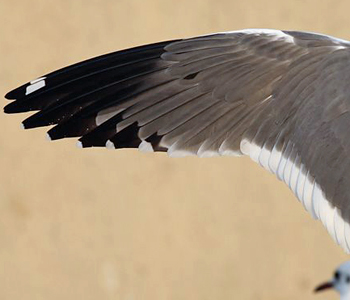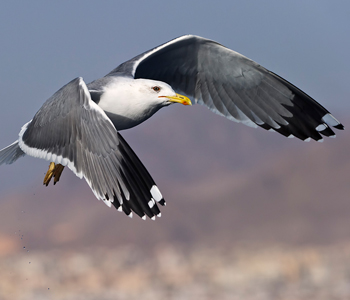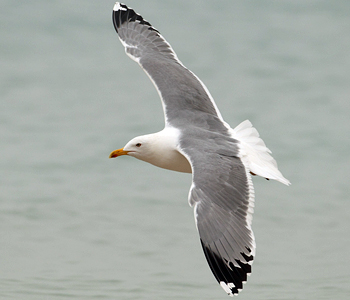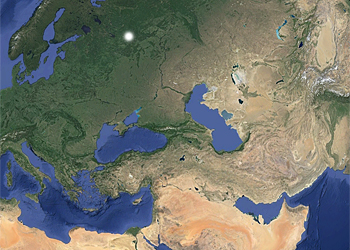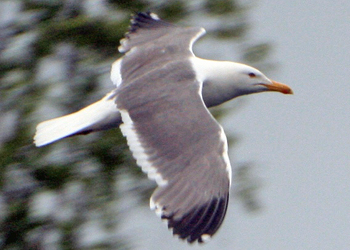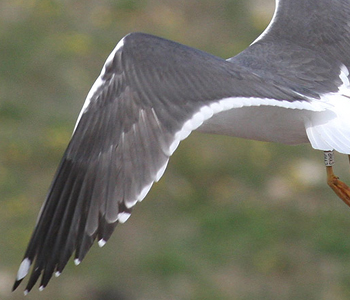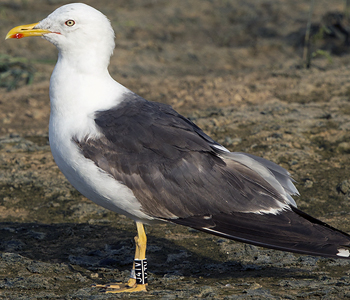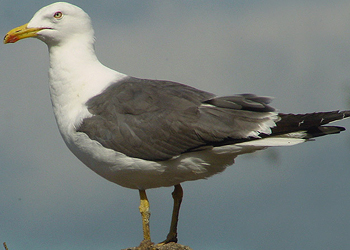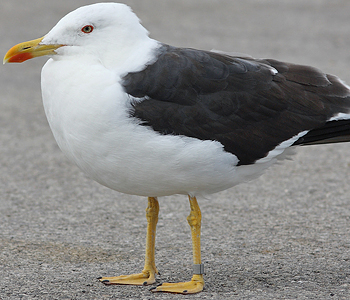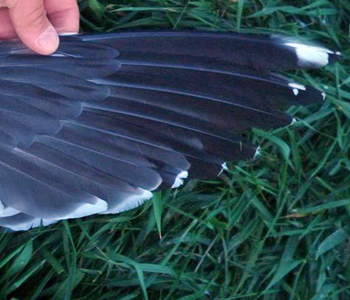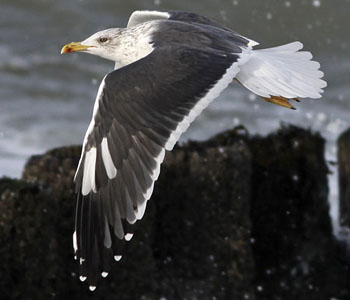 nominate Lesser Black-backed Gull (L. f. fuscus)
nominate Lesser Black-backed Gull (L. f. fuscus)
(last update:
Amir Ben Dov (Israel)
Hannu Koskinen (Finland)
Mars Muusse (the Netherlands)
fuscus 1cy July
fuscus 1cy Aug
fuscus 1cy Sept
fuscus 1cy Oct
fuscus 1cy Nov
fuscus 1cy Dec
fuscus 2cy Jan
fuscus 2cy Feb
fuscus 2cy March
fuscus 2cy April
fuscus 2cy May
fuscus 2cy June
fuscus 2cy July
fuscus 2cy Aug
fuscus 2cy Sept
fuscus 2cy Oct
fuscus 2cy Nov
fuscus 2cy Dec
fuscus 3cy Jan
fuscus 3cy Feb
fuscus 3cy March
fuscus 3cy April
fuscus 3cy May
fuscus 3cy June
fuscus 3cy July
fuscus 3cy August
fuscus 3cy Sept
fuscus 3cy October
fuscus 3cy Nov
fuscus 3cy Dec
fuscus 4cy Jan
fuscus 4cy Feb
fuscus 4cy March
fuscus 4cy April
fuscus 4cy May
fuscus 4cy June
fuscus 4cy July
fuscus 4cy Aug
fuscus 4cy Sept
fuscus 4cy Oct
fuscus 4cy Nov
fuscus 4cy Dec
fuscus ad Jan
fuscus ad Feb
fuscus ad March
fuscus ad April
fuscus ad May
fuscus ad June
fuscus ad July
fuscus ad Aug
fuscus unringed Aug
fuscus ad Sept
fuscus ad Oct
fuscus ad Nov
fuscus ad Dec
adult fuscus: July
The grey invasion:
"increase of pale-backed Lesser Black-backed Gulls in the heartlands of nominate fuscus."
One of the major difficulties in gull identification is separating adult Scandinavian intermedius from Siberian heuglini. Variation in plumage of intermedius can be studied along the Atlantic migartion route and in their colonies (there are extensive ringing projects in S Norway and in Denmark, but heuglini is nowhere really abundant. Best place seems to be the near East, especially Israel, and the Gulf states. But what we find there, is that really all heuglini? Sure it is the most common 'slaty grey' Lesser Black-backed Gull, but ring readings indicate one has to careful. Below some example birds.

Resting flock of fuscus at Tampere dump, Finland.

Bulldozer at household waste, with dominance of argentatus and ridibundus.

Biowaste I: favored place by fuscus.
Primary moult
The moult sequence in nominate Lesser Black-backed Gull Larus fuscus fuscus was already described by Stresemann & Stresemann in 1966 in Journal für Ornithologie. They described a periodische Staffelmauser, a step-wise moult. Normally, large white-headed gulls in Europe start replacement of the remiges during the breeding season and finish this moult in autumn, prior to their migration. Compared to fuscus, this is a relative short distance migration.
Stresemann & Stresemann describe fuscus as an exception as it doesn't start the remiges moult before arriving at the wintering grounds in Africa and the Mediterranean. For a long-distance migrant like fuscus, this seems to be a suitable strategy. This pattern can also be found in long-distance migrants like Terns (Sternidae).
Stresemann & Stresemann examined skin collections and failed to find any adult L. f. fuscus originating from the breeding or autumn migratory range that was in active primary moult. Therefore they presumed the entire moult stage takes place on the wintering grounds. Adult birds on migration had been collected (Rossitten Bird Observatory, Russia) and these birds confirmed the theses: they must have suspended moult, as Heinroth (1928, Die Vögel Mitteleuropas) concluded: adult fuscus doesn't show active primary moult on migration. They either suspend moult or do not commence moult before arrival on the wintering grounds.
However, there are a few museum skins that do show adult fuscus in primary moult: the Zoological Museum of Helsinki (not visited by the Stresemanns in 1966) has 21 skins of summer / early autumn birds: 8 are showing moult in the primaries. The museums of Copenhagen and Tring have 10 skins in collecting from the same period: one is showing active primary moult.
The last decades, the general idea about the renewal of the primaries in adult fuscus has been changed slightly. Field research showed that a small majority (up to 60% in southern Sweden) of the adult fuscus have started to replace the inner one or two primaries on the breeding ground by late August. This primary moult is suspended until arrival at the tropical wintering grounds. Fuscus complete their primary moult in February and March, just before leaving again to the breeding grounds in Scandinavia and northern Russia. By March, the inner primaries may in some birds included in the primary moult, in a second wave. This seems to be a common feature in sub-adults.
Hario and primary moult in fuscus
An interesting article about primary moult in Finland has been published by Ornis Fennica (61/1984): Onset and pattern of primary moult in the Lesser Black-backed Gull Larus f. fuscus - a comparison with the Herring Gull, written by Martti Hario. Hario, working for the Game & Fishery Institute in Helsinki, did a four year investigation (breeding seasons of 1980-83) in the outer archipelago of the Gulf of Finland, 25 km SE of Helsinki (60.07N-25.25E). This archipelago hosts a small mixed colony of fuscus and argentatus, with about 25 pairs of both species, but steadily declining numbers of fuscus. Systematically, shed feathers of both fuscus and argentatus were collected from the time eggs were laid up to September. During the visits, the number of birds were noted and the breeding success was studied in detail. By collecting the shed primaries systematically, Hario was sure about the feathers being shed very recently (he worked on a daily basis for most of the period). To draw his main conclusion, Hario plotted the length of the newly shed primaries against time (n = 337 for argentatus, n = 137 for fuscus) to get a linear regression analysis.
From early May argentatus shed primaries, starting with the innermost primaries, P1, P2, etc. until P10 is dropped. This is clearly demonstrated by the length of the shed primaries Hario collected; getting longer as time progresses. The first collected primaries in May are about 180 mm in length, the last shed primaries, collected in early August are about 280 mm and clearly apply to the longer outer primaries. From early August onwards, adult argentatus normally abandon the colony and may still have the old outermost primaries present.
The figure for fuscus is completely different with the length of the shed primaries staying more or less the same over a period of three months (regression coefficient only 0.05, with coefficient for argentatus 0.89). Thus, fuscus only moults the short inner primaries in the study area in southern Finland, probably primaries P1, P2 and occasionally (?) P3. Moult is then interrupted or continued outside the study area.
Argentatus left the colony in the study area as the young fledglings were leaving the area. Fuscus on the contrary remained in the area, despite the poor breeding results and stayed up to the end of August; last birds were seen mid-September.
| Table 1 from M. Hario (1984): Numbers of shed primaries collected in the study area and sizes of breeding gull populations (ind.) in different years. | ||||
| . | L. f. fuscus | L. argentatus | ||
| . | primaries | breeding birds | primaries | breeding birds |
| 1980 | 38 | 62 | 52 | 50 |
| 1981 | 11 | 64 | 108 | 50 |
| 1982 | 46 | 44 | 114 | 52 |
| 1983 | 42 | 30 | 63 | 42 |
Hario found no statistical difference in feathers from left or right wing. Hence, birds moulting P1 or P2 (and occasionally P3), the average number of birds shedding primaries would be 17 or 9 (or 6) respectively. From table 1, one may conclude this represents 34% or 18% (or 12%) of the fuscus population in 1980-1983. This is a minority, but substantial number of adult fuscus.
Hario didn't only check the timing of moult, he also noted the patterns of primary moult. He collected newly shed primaries of fuscus and argentatus and as expected, the primaries of argentatus were pretty worn, being almost a year old. Remarkably, this wasn't always the case in fuscus. Some shed inner primaries were very fresh, with the clear white tip still visible. This is so remarkable, considering the much longer migration route for fuscus and the exposure to desert sun in the equatorial summer. The difference in wear suggest a difference in age of the feathers. Hario found only small numbers of intermediates. Exactly in line with the findings of Stresemann & Stresemann's 'periodische Staffelmauser'. Hario estimates the fresh primaries to be only 1-2 months of age, which is the time interval between arrival at the breeding grounds and completion of the second moult wave in the inner primaries. Thus the fresh primaries belong to birds having moulted stepwise, and the worn ones to those having moulted 'normally'.
| Table 2 from M. Hario (1984): Proportions of fresh and worn primaries of L. f. fuscus and those of intermediate type collected in the study area. | |||||||
| . | fresh | worn | intermediate | total | |||
| . | n | % | n | % | n | % | . |
| 1980 | 6 | 16 | 27 | 71 | 5 | 12 | 38 |
| 1981 | 5 | 45 | 6 | 55 | 0 | - | 11 |
| 1982 | 3 | 7 | 42 | 91 | 1 | 2 | 46 |
| 1983 | 7 | 17 | 31 | 74 | 4 | 9 | 42 |
| average | . | 21 | . | 73 | . | 6 | . |
The proportion of birds moulting stepwise average 20% of the moulting adults. As demonstrated earlier, about 18-34% (lower limit may be 12%) of adult fuscus shed primaries by late summer - early autumn but the proportion of stepwise moulting birds in the total population can be estimated as the moult strategy in non-moulting birds is unknown.
In discussing the primary moult of adult fuscus on the breeding grounds, Hario questions whether fuscus may start moulting earlier because of the great loss of chicks and the poor breeding success. About 90% of the fuscus chicks had died before the start of the primary moult in adults. Nevertheless, the commencement of the primary moult takes place with a one-month time gap and there are no indications adults start moulting earlier and stays the same as in the 1960's. Barth, who based his findings on samples from 1962-1970 draws the same conclusion: primary moult starts at earliest from mid-July and commonly on August 10. But there is a slight change that, given the 'surplus' time between failed breeding and migration, fuscus may start the primary moult earlier in the next generations. For a summary of Barth's article, click here.
The survey on primary moult in adult fuscus was repeated by Lars Jonsson on Gotland. In his article "Baltic Lesser Black-backed Gull Larus fuscus fuscus - moult ageing and identification" in Birding World 11-8 1998 he mentions this research op page 303.
"I have systematically checked fuscus resting at the southern top of Gotland for primary moult from July through to mid September and have found that 60% of the fully adult-looking birds have started the renewal of their innermost one or two primaries by the end of August".
He doesn't enlarge upon these figures and there is no table included showing total numbers included in this survey, but the '60%' is substantial larger than the '25%' estimation of Hario. A few factors may have influenced this estimation:
- Jonsson's research extended much longer, into September, and may have included birds commencing primary moult in a later stage.
- Jonsson included all adult-looking birds, and he may have included near-adults as well. Near-adults may still start the renewal earlier than true adults. Hario, checking breeding adults in the colony, had probably lower numbers of 4cy and 5cy birds.
- Jonsson's research was done in the mid and late 90's, and, given the poorer and poorer breeding successes for fuscus in the last decades, there may be a minor shift in moult strategy due to 'surplus energy and surplus time', as was questioned by Hario in the early 80's.
 LBBG fuscus 11cy CA15,
July 11 2003, Tampere, Finland
(61.33N 24.59E). Ringed as pullus at Palkan,
Finland on July 01 1993, now in 11cy.
LBBG fuscus 11cy CA15,
July 11 2003, Tampere, Finland
(61.33N 24.59E). Ringed as pullus at Palkan,
Finland on July 01 1993, now in 11cy. LBBG fuscus 11cy CA28,
July 11 2003, Tampere, Finland
(61.33N 24.59E). Ringed as pullus at Palkan,
Finland on July 01 1993. P1-P10 still old.
LBBG fuscus 11cy CA28,
July 11 2003, Tampere, Finland
(61.33N 24.59E). Ringed as pullus at Palkan,
Finland on July 01 1993. P1-P10 still old. LBBG fuscus 11cy CA67,
July 09 2003, Tampere, Finland
(61.33N 24.59E). Ringed as pullus at Punkah,
Finland on July 04 1993, now in 11cy. All primaries still old.
LBBG fuscus 11cy CA67,
July 09 2003, Tampere, Finland
(61.33N 24.59E). Ringed as pullus at Punkah,
Finland on July 04 1993, now in 11cy. All primaries still old. LBBG fuscus 11cy CA82,
July 09-14 2003, Tampere, Finland
(61.33N 24.59E). Ringed as pullus at Punkah,
Finland on July 05 1993, now in 11cy. All primaries still old.
LBBG fuscus 11cy CA82,
July 09-14 2003, Tampere, Finland
(61.33N 24.59E). Ringed as pullus at Punkah,
Finland on July 05 1993, now in 11cy. All primaries still old. LBBG fuscus 11cy CE05,
July 09-17 2003, Tampere, Finland
(61.33N 24.59E). Ringed as pullus at Korpil,
Finland on July 03 1993, now in 11cy. P1-P10 old.
LBBG fuscus 11cy CE05,
July 09-17 2003, Tampere, Finland
(61.33N 24.59E). Ringed as pullus at Korpil,
Finland on July 03 1993, now in 11cy. P1-P10 old. LBBG fuscus 11cy CE10,
July 09-16 2003, Tampere, Finland
(61.33N 24.59E). Ringed as pullus at Korpil,
Finland on July 03 1993, now in 11cy.
LBBG fuscus 11cy CE10,
July 09-16 2003, Tampere, Finland
(61.33N 24.59E). Ringed as pullus at Korpil,
Finland on July 03 1993, now in 11cy. LBBG fuscus 11cy CH03,
July 10 2003, Tampere, Finland
(61.33N 24.59E). Ringed as pullus at Tampere,
Finland on July 11 1993, now in 11cy. All primaries still old.
LBBG fuscus 11cy CH03,
July 10 2003, Tampere, Finland
(61.33N 24.59E). Ringed as pullus at Tampere,
Finland on July 11 1993, now in 11cy. All primaries still old. LBBG fuscus 11cy CH08,
July 09-15 2003, Tampere, Finland
(61.33N 24.59E). Ringed as pullus at Ylojar,
Finland on July 17 1993, now in 11cy.
LBBG fuscus 11cy CH08,
July 09-15 2003, Tampere, Finland
(61.33N 24.59E). Ringed as pullus at Ylojar,
Finland on July 17 1993, now in 11cy. LBBG fuscus 10cy CS 47,
July 09-17 2003, Tampere, Finland
(61.33N 24.59E). Ringed as pullus at Padasj,
Finland on July 21 1994, now in 10cy.
LBBG fuscus 10cy CS 47,
July 09-17 2003, Tampere, Finland
(61.33N 24.59E). Ringed as pullus at Padasj,
Finland on July 21 1994, now in 10cy. LBBG fuscus 10cy CJ 93,
July 11-12 2003, Tampere, Finland
(61.33N 24.59E). Ringed as pullus at
Helsinki,
Finland on July 10 1994, now in 10cy.
LBBG fuscus 10cy CJ 93,
July 11-12 2003, Tampere, Finland
(61.33N 24.59E). Ringed as pullus at
Helsinki,
Finland on July 10 1994, now in 10cy. LBBG fuscus 9cy CJ 59,
July 09-17 2003, Tampere, Finland
(61.33N 24.59E). Ringed as pullus at Ylojar,
Finland on July 11 1995, now in 9cy. All primaries still old.
LBBG fuscus 9cy CJ 59,
July 09-17 2003, Tampere, Finland
(61.33N 24.59E). Ringed as pullus at Ylojar,
Finland on July 11 1995, now in 9cy. All primaries still old.  LBBG fuscus 9cy C0 62,
July 09-17 2003, Tampere, Finland
(61.33N 24.59E). Ringed as pullus at Kuopio,
Finland on July 08 1995, now in 9cy.
LBBG fuscus 9cy C0 62,
July 09-17 2003, Tampere, Finland
(61.33N 24.59E). Ringed as pullus at Kuopio,
Finland on July 08 1995, now in 9cy. LBBG fuscus 9cy C3 28,
July 10 2003, Tampere, Finland
(61.33N 24.59E). Ringed as pullus at Ikaali,
Finland on July 05 1995, now in 9cy. P1 new, P2-P10 old.
LBBG fuscus 9cy C3 28,
July 10 2003, Tampere, Finland
(61.33N 24.59E). Ringed as pullus at Ikaali,
Finland on July 05 1995, now in 9cy. P1 new, P2-P10 old. LBBG fuscus 9cy & 18cy C104 July 2003 & April 2012, Tampere, Finland & Kaunuas Luthuania. Ringed as pullus at Palkan,
Finland on July 01 1995.
LBBG fuscus 9cy & 18cy C104 July 2003 & April 2012, Tampere, Finland & Kaunuas Luthuania. Ringed as pullus at Palkan,
Finland on July 01 1995. LBBG fuscus 9cy C120,
August 2002 & July 2003, Tampere, Finland
(61.33N 24.59E). Ringed as pullus at Palkan,
Finland on July 02 1995, now in 9cy.
LBBG fuscus 9cy C120,
August 2002 & July 2003, Tampere, Finland
(61.33N 24.59E). Ringed as pullus at Palkan,
Finland on July 02 1995, now in 9cy. LBBG fuscus 9cy C122,
July 15-17 2003, Tampere, Finland
(61.33N 24.59E). Ringed as pullus at Palkan,
Finland on July 02 1995, now in 9cy.
LBBG fuscus 9cy C122,
July 15-17 2003, Tampere, Finland
(61.33N 24.59E). Ringed as pullus at Palkan,
Finland on July 02 1995, now in 9cy. LBBG fuscus 9cy C127,
July 12-17 2003, Tampere, Finland
(61.33N 24.59E). Ringed as pullus at Palkan,
Finland on July 02 1995, now in 9cy.
LBBG fuscus 9cy C127,
July 12-17 2003, Tampere, Finland
(61.33N 24.59E). Ringed as pullus at Palkan,
Finland on July 02 1995, now in 9cy.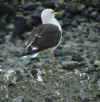 LBBG fuscus 9cy C134,
July 11 2003, Tampere, Finland
(61.33N 24.59E). Ringed as pullus at Kanala,
Finland on July 02 1995, now in 9cy.
LBBG fuscus 9cy C134,
July 11 2003, Tampere, Finland
(61.33N 24.59E). Ringed as pullus at Kanala,
Finland on July 02 1995, now in 9cy. LBBG fuscus 8cy CX12,
August 2002 & July 2003, Tampere, Finland
(61.33N 24.59E). Ringed as pullus at Kanala on June 30
1996.
LBBG fuscus 8cy CX12,
August 2002 & July 2003, Tampere, Finland
(61.33N 24.59E). Ringed as pullus at Kanala on June 30
1996. LBBG fuscus 8cy CX18,
July 10-16 2003, Tampere, Finland
(61.33N 24.59E). Ringed as pullus at Kanala,
Finland on June 30 1996, now in 8cy. All primaries still old.
LBBG fuscus 8cy CX18,
July 10-16 2003, Tampere, Finland
(61.33N 24.59E). Ringed as pullus at Kanala,
Finland on June 30 1996, now in 8cy. All primaries still old. LBBG fuscus 8cy CX19,
August 2002 & July 2003, Tampere, Finland (61.33N 24.59E). Ringed as pullus at Kanala, Finland on June 30 1996.
LBBG fuscus 8cy CX19,
August 2002 & July 2003, Tampere, Finland (61.33N 24.59E). Ringed as pullus at Kanala, Finland on June 30 1996. LBBG fuscus 8cy CX78, July
16 2003, Tampere, Finland (61.33N 24.59E). Ringed as pullus at Pälkäne, Finland on June 29 1996.
LBBG fuscus 8cy CX78, July
16 2003, Tampere, Finland (61.33N 24.59E). Ringed as pullus at Pälkäne, Finland on June 29 1996. LBBG fuscus 8cy CX98,
August 2002 & July 2003, Tampere, Finland (61.33N 24.59E). Ringed as pullus at Pälkäne, Finland in 1996. P1-P10 old.
LBBG fuscus 8cy CX98,
August 2002 & July 2003, Tampere, Finland (61.33N 24.59E). Ringed as pullus at Pälkäne, Finland in 1996. P1-P10 old. LBBG fuscus 8cy CX99, July
17 2003, Tampere, Finland (61.33N 24.59E). Ringed as pullus at Pälkäne, Finland in 1996.
LBBG fuscus 8cy CX99, July
17 2003, Tampere, Finland (61.33N 24.59E). Ringed as pullus at Pälkäne, Finland in 1996. LBBG fuscus 8cy C1C2,
July 11-17 2003, Tampere, Finland
(61.33N 24.59E). Ringed as pullus at Pälkäne,
Finland in 1996, now in 8cy.
LBBG fuscus 8cy C1C2,
July 11-17 2003, Tampere, Finland
(61.33N 24.59E). Ringed as pullus at Pälkäne,
Finland in 1996, now in 8cy. LBBG fuscus 8cy C72Y,
July 10 2003, Tampere, Finland
(61.33N 24.59E). Ringed as pullus at Palkan,
Finland on June 29 1996, now in 8cy. All primaries still old.
LBBG fuscus 8cy C72Y,
July 10 2003, Tampere, Finland
(61.33N 24.59E). Ringed as pullus at Palkan,
Finland on June 29 1996, now in 8cy. All primaries still old. LBBG fuscus 8cy C95C,
July 12 2003, Tampere, Finland
(61.33N 24.59E). Ringed as pullus at Kanala,
Finland on July 16 1996, now in 8cy.
LBBG fuscus 8cy C95C,
July 12 2003, Tampere, Finland
(61.33N 24.59E). Ringed as pullus at Kanala,
Finland on July 16 1996, now in 8cy. LBBG fuscus 8cy C23C,
July 15 2003, Tampere, Finland
(61.33N 24.59E). Ringed as pullus at Palkan,
Finland on June 29 1996, now in 8cy.
LBBG fuscus 8cy C23C,
July 15 2003, Tampere, Finland
(61.33N 24.59E). Ringed as pullus at Palkan,
Finland on June 29 1996, now in 8cy. LBBG fuscus 8cy C22C,
July 12 2003, Tampere, Finland
(61.33N 24.59E). Ringed as pullus at Palkan,
Finland on June 29 1996, now in 8cy.
LBBG fuscus 8cy C22C,
July 12 2003, Tampere, Finland
(61.33N 24.59E). Ringed as pullus at Palkan,
Finland on June 29 1996, now in 8cy. LBBG fuscus 7cy C18C,
July 16 2003, Tampere, Finland
(61.33N 24.59E). Ringed as pullus at Vkoski,
Finland in 1997, now in 8cy.
LBBG fuscus 7cy C18C,
July 16 2003, Tampere, Finland
(61.33N 24.59E). Ringed as pullus at Vkoski,
Finland in 1997, now in 8cy. LBBG fuscus 7cy C11C,
July 12 2003, Tampere, Finland
(61.33N 24.59E). Ringed as pullus at Ylojar,
Finland on July 08 1997, now in 7cy.
LBBG fuscus 7cy C11C,
July 12 2003, Tampere, Finland
(61.33N 24.59E). Ringed as pullus at Ylojar,
Finland on July 08 1997, now in 7cy. LBBG fuscus 7cy C04C,
August 2002 & July 2003, Tampere, Finland
(61.33N 24.59E). Ringed as pullus at Ylojar,
Finland on July 08 1997, now in 7cy. All primaries still old.
LBBG fuscus 7cy C04C,
August 2002 & July 2003, Tampere, Finland
(61.33N 24.59E). Ringed as pullus at Ylojar,
Finland on July 08 1997, now in 7cy. All primaries still old. LBBG fuscus 7cy C06C,
July 09-17 2003, Tampere, Finland
(61.33N 24.59E). Ringed as pullus at Ylojar,
Finland on July 08 1997, now in 7cy. All primaries still old.
LBBG fuscus 7cy C06C,
July 09-17 2003, Tampere, Finland
(61.33N 24.59E). Ringed as pullus at Ylojar,
Finland on July 08 1997, now in 7cy. All primaries still old. L. f. fuscus 5cy-10cy C1AR August 2004 - May 2009, Tampere, Finland. Images Hannu Koskinen & Visa Rauste.
L. f. fuscus 5cy-10cy C1AR August 2004 - May 2009, Tampere, Finland. Images Hannu Koskinen & Visa Rauste. LBBG fuscus 7cy C2H1,
July 09-12 2003, Tampere, Finland
(61.33N 24.59E). Ringed as pullus at Saaksm,
Finland on July 02 1997, now in 7cy. P1-P4 fresh, P5-P10 older.
LBBG fuscus 7cy C2H1,
July 09-12 2003, Tampere, Finland
(61.33N 24.59E). Ringed as pullus at Saaksm,
Finland on July 02 1997, now in 7cy. P1-P4 fresh, P5-P10 older. LBBG fuscus 7cy C2L5,
July 14-17 2003, Tampere, Finland
(61.33N 24.59E). Ringed as pullus at Ikaali,
Finland on July 01 1997, now in 7cy.
LBBG fuscus 7cy C2L5,
July 14-17 2003, Tampere, Finland
(61.33N 24.59E). Ringed as pullus at Ikaali,
Finland on July 01 1997, now in 7cy. LBBG fuscus 7cy C5H2,
July 14-16 2003, Tampere, Finland
(61.33N 24.59E). Ringed as pullus at Pälkäne in 1997, now in 7cy.
LBBG fuscus 7cy C5H2,
July 14-16 2003, Tampere, Finland
(61.33N 24.59E). Ringed as pullus at Pälkäne in 1997, now in 7cy. LBBG fuscus 7cy C5S1,
July 11 2003, Tampere, Finland
(61.33N 24.59E). Ringed as pullus at Tampere,
Finland on July 13 1997, now in 7cy.
LBBG fuscus 7cy C5S1,
July 11 2003, Tampere, Finland
(61.33N 24.59E). Ringed as pullus at Tampere,
Finland on July 13 1997, now in 7cy. LBBG fuscus 7cy C6R9,
July 15 2003, Tampere, Finland
(61.33N 24.59E). Ringed as pullus at Kanala in 1997, now in 7cy.
LBBG fuscus 7cy C6R9,
July 15 2003, Tampere, Finland
(61.33N 24.59E). Ringed as pullus at Kanala in 1997, now in 7cy. LBBG fuscus 7cy C7R7,
July 09-15 2003, Tampere, Finland
(61.33N 24.59E). Ringed as pullus at Luopio,
Finland on June 30 1997, now in 7cy. All primaries still old.
LBBG fuscus 7cy C7R7,
July 09-15 2003, Tampere, Finland
(61.33N 24.59E). Ringed as pullus at Luopio,
Finland on June 30 1997, now in 7cy. All primaries still old. Larus
fuscus fuscusC69E,
August 2002 & July 2003, Tampere, Finland (61.33N 24.59E). Ringed as pullus at Kanala, Finland on July 03 1997.
Larus
fuscus fuscusC69E,
August 2002 & July 2003, Tampere, Finland (61.33N 24.59E). Ringed as pullus at Kanala, Finland on July 03 1997. LBBG fuscus 7cy C72E,
July 10-15 2003, Tampere, Finland
(61.33N 24.59E). Ringed as pullus at Kanala, in 1997, now in 7cy.
LBBG fuscus 7cy C72E,
July 10-15 2003, Tampere, Finland
(61.33N 24.59E). Ringed as pullus at Kanala, in 1997, now in 7cy. LBBG fuscus 7cy C8C4,
July 10-16 2003, Tampere, Finland
(61.33N 24.59E). Ringed as pullus at Korpil,
Finland on July 12 1997, now in 7cy. All primaries still old.
LBBG fuscus 7cy C8C4,
July 10-16 2003, Tampere, Finland
(61.33N 24.59E). Ringed as pullus at Korpil,
Finland on July 12 1997, now in 7cy. All primaries still old. LBBG fuscus 7cy HT 025.258,
July 16 2003, Tampere, Finland
(61.33N 24.59E). Ringed as pullus at Palkan,
Finland on June 27 1997, now in 7cy.
LBBG fuscus 7cy HT 025.258,
July 16 2003, Tampere, Finland
(61.33N 24.59E). Ringed as pullus at Palkan,
Finland on June 27 1997, now in 7cy. LBBG fuscus 7cy HT 025.330,
July 11-14 2003, Tampere, Finland
(61.33N 24.59E). Ringed as pullus at Palkan,
Finland on July 07 1997, now in 7cy.
LBBG fuscus 7cy HT 025.330,
July 11-14 2003, Tampere, Finland
(61.33N 24.59E). Ringed as pullus at Palkan,
Finland on July 07 1997, now in 7cy. LBBG fuscus 6cy HT 203.880,
July 10 2003, Tampere, Finland
(61.33N 24.59E). Ringed as pullus at Palkan,
Finland on July 03 1998, now in 6cy.
LBBG fuscus 6cy HT 203.880,
July 10 2003, Tampere, Finland
(61.33N 24.59E). Ringed as pullus at Palkan,
Finland on July 03 1998, now in 6cy. LBBG fuscus 6cy C2H9,
August 2002 & July 2003, Tampere, Finland (61.33N 24.59E). Ringed as pullus at Palkan, Finland on July 09 1998, Sub-adult in 2002.
LBBG fuscus 6cy C2H9,
August 2002 & July 2003, Tampere, Finland (61.33N 24.59E). Ringed as pullus at Palkan, Finland on July 09 1998, Sub-adult in 2002. LBBG fuscus 6cy C3H4,
July 10-17 2003, Tampere, Finland
(61.33N 24.59E). Ringed as pullus at Palkan,
Finland on July 09 1998, now in 6cy. P9-P10 old, P10 with a large mirror.
LBBG fuscus 6cy C3H4,
July 10-17 2003, Tampere, Finland
(61.33N 24.59E). Ringed as pullus at Palkan,
Finland on July 09 1998, now in 6cy. P9-P10 old, P10 with a large mirror. LBBG fuscus 6cy CAA1,
July 09-11 2003, Tampere, Finland
(61.33N 24.59E). Ringed as pullus at Tampere,
Finland on July 11 1998, now in 6cy. P1 new, P2 growing, P3-P10 old.
LBBG fuscus 6cy CAA1,
July 09-11 2003, Tampere, Finland
(61.33N 24.59E). Ringed as pullus at Tampere,
Finland on July 11 1998, now in 6cy. P1 new, P2 growing, P3-P10 old. LBBG fuscus 6cy CAC6,
July 09-12 2003, Tampere, Finland
(61.33N 24.59E). Ringed as pullus at Ylojar,
Finland on July 11 1998, now in 6cy.
LBBG fuscus 6cy CAC6,
July 09-12 2003, Tampere, Finland
(61.33N 24.59E). Ringed as pullus at Ylojar,
Finland on July 11 1998, now in 6cy. LBBG fuscus 6cy CAW1,
July 12-15 2003, Tampere, Finland
(61.33N 24.59E). Ringed as pullus at Kanala,
Finland on June 30 1998, now in 6cy. P1-P5 fresh, P6-P10 older.
LBBG fuscus 6cy CAW1,
July 12-15 2003, Tampere, Finland
(61.33N 24.59E). Ringed as pullus at Kanala,
Finland on June 30 1998, now in 6cy. P1-P5 fresh, P6-P10 older. LBBG fuscus 6cy CAW3,
July 10-16 2003, Tampere, Finland
(61.33N 24.59E). Ringed as pullus at Palkan,
Finland on June 30 1998, now in 6cy.
LBBG fuscus 6cy CAW3,
July 10-16 2003, Tampere, Finland
(61.33N 24.59E). Ringed as pullus at Palkan,
Finland on June 30 1998, now in 6cy. Larus
fuscus fuscusCAX2,
August 2002 & July 2003, Tampere, Finland (61.33N 24.59E). Ringed as pullus at Kanala, Finland on June 30 1998.
Larus
fuscus fuscusCAX2,
August 2002 & July 2003, Tampere, Finland (61.33N 24.59E). Ringed as pullus at Kanala, Finland on June 30 1998. LBBG fuscus 6cy CJK7,
August 2002 & July 2003, Tampere, Finland
(61.33N 24.59E). Ringed as pullus at Kanala in June
1998. All primaries still old.
LBBG fuscus 6cy CJK7,
August 2002 & July 2003, Tampere, Finland
(61.33N 24.59E). Ringed as pullus at Kanala in June
1998. All primaries still old. LBBG fuscus 6cy CJM3,
July 09-15 2003, Tampere, Finland
(61.33N 24.59E). Ringed as pullus at Palkan,
Finland on June 28 1998, now in 6cy. All primaries still old.
LBBG fuscus 6cy CJM3,
July 09-15 2003, Tampere, Finland
(61.33N 24.59E). Ringed as pullus at Palkan,
Finland on June 28 1998, now in 6cy. All primaries still old. LBBG fuscus 6cy CJN1,
July 15 2003, Tampere, Finland
(61.33N 24.59E). Ringed as pullus at Hauho,
Finland on June 29 1998, now in 6cy. All primaries still old.
LBBG fuscus 6cy CJN1,
July 15 2003, Tampere, Finland
(61.33N 24.59E). Ringed as pullus at Hauho,
Finland on June 29 1998, now in 6cy. All primaries still old. LBBG fuscus 6cy CJS6,
July 09-15 2003, Tampere, Finland
(61.33N 24.59E). Ringed as pullus at Palkan,
Finland on June 28 1998, now in 6cy.
LBBG fuscus 6cy CJS6,
July 09-15 2003, Tampere, Finland
(61.33N 24.59E). Ringed as pullus at Palkan,
Finland on June 28 1998, now in 6cy. LBBG fuscus 6cy CKA5,
August 2002 & July 2003, Tampere, Finland
(61.33N 24.59E). Ringed as pullus at Kanala, in 1998.
LBBG fuscus 6cy CKA5,
August 2002 & July 2003, Tampere, Finland
(61.33N 24.59E). Ringed as pullus at Kanala, in 1998. LBBG fuscus 6cy CNN2,
August 2002 &
July 2003, Tampere, Finland
(61.33N 24.59E). Ringed as pullus in 1998. Active moult
in inner primaries.
LBBG fuscus 6cy CNN2,
August 2002 &
July 2003, Tampere, Finland
(61.33N 24.59E). Ringed as pullus in 1998. Active moult
in inner primaries. LBBG fuscus 5cy C2ER,
July 09-17 2003, Tampere, Finland
(61.33N 24.59E). Ringed as pullus at Palkan,
Finland on July 03 1999, now in 5cy. All primaries still old.
LBBG fuscus 5cy C2ER,
July 09-17 2003, Tampere, Finland
(61.33N 24.59E). Ringed as pullus at Palkan,
Finland on July 03 1999, now in 5cy. All primaries still old. LBBG fuscus 6+cy C3KU,
July 09-11 2003, Tampere, Finland
(61.33N 24.59E). Ringed as 2+cy at Tampere,
Finland on August 07 1999, now in 6+cy.
LBBG fuscus 6+cy C3KU,
July 09-11 2003, Tampere, Finland
(61.33N 24.59E). Ringed as 2+cy at Tampere,
Finland on August 07 1999, now in 6+cy. LBBG fuscus 7+cy C5KV,
July 11-17 2003, Tampere, Finland
(61.33N 24.59E). Ringed as 3+cy at Tampere,
Finland on August 14 1999, now in 7+cy.
LBBG fuscus 7+cy C5KV,
July 11-17 2003, Tampere, Finland
(61.33N 24.59E). Ringed as 3+cy at Tampere,
Finland on August 14 1999, now in 7+cy. LBBG fuscus 5cy C0EN,
August 2002 &
July 2003, Tampere, Finland
(61.33N 24.59E). Ringed as pullus at Palkan in 1999.
LBBG fuscus 5cy C0EN,
August 2002 &
July 2003, Tampere, Finland
(61.33N 24.59E). Ringed as pullus at Palkan in 1999. LBBG fuscus 5cy C1AK,
August 2002 &
July 2003, Tampere, Finland
(61.33N 24.59E). Ringed as pullus at Kanala in 1999.
LBBG fuscus 5cy C1AK,
August 2002 &
July 2003, Tampere, Finland
(61.33N 24.59E). Ringed as pullus at Kanala in 1999. LBBG fuscus 5cy C1ER,
July 09-17 2003, Tampere, Finland
(61.33N 24.59E). Ringed as pullus at Palkan in 1999. All
primaries old.
LBBG fuscus 5cy C1ER,
July 09-17 2003, Tampere, Finland
(61.33N 24.59E). Ringed as pullus at Palkan in 1999. All
primaries old. LBBG fuscus 5+cy C2PE,
August 2002 & July 2003, Tampere, Finland
(61.33N 24.59E). Ringed as 3+cy at Hauho in 2001.
LBBG fuscus 5+cy C2PE,
August 2002 & July 2003, Tampere, Finland
(61.33N 24.59E). Ringed as 3+cy at Hauho in 2001. LBBG fuscus 5cy C3EX,
July 15-17 2003, Tampere, Finland
(61.33N 24.59E). Ringed as pullus at Luopio,
Finland on July 02 1999.
LBBG fuscus 5cy C3EX,
July 15-17 2003, Tampere, Finland
(61.33N 24.59E). Ringed as pullus at Luopio,
Finland on July 02 1999.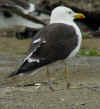 LBBG fuscus 5cy C6EN,
July 11-16 2003, Tampere, Finland
(61.33N 24.59E). Ringed as pullus at Palkan,
Finland on July 02 1999, now in 5cy.
LBBG fuscus 5cy C6EN,
July 11-16 2003, Tampere, Finland
(61.33N 24.59E). Ringed as pullus at Palkan,
Finland on July 02 1999, now in 5cy. LBBG fuscus 5cy C6KV,
July 12-15 2003, Tampere, Finland
(61.33N 24.59E). Ringed as 1cy at Tampere,
Finland on August 14 1999, now in 5cy.
LBBG fuscus 5cy C6KV,
July 12-15 2003, Tampere, Finland
(61.33N 24.59E). Ringed as 1cy at Tampere,
Finland on August 14 1999, now in 5cy. LBBG fuscus 5cy C7EU,
July 09-10 2003, Tampere, Finland
(61.33N 24.59E). Ringed as pullus at Hauho,
Finland on July 04 1999, now in 5cy. All primaries still old.
LBBG fuscus 5cy C7EU,
July 09-10 2003, Tampere, Finland
(61.33N 24.59E). Ringed as pullus at Hauho,
Finland on July 04 1999, now in 5cy. All primaries still old. LBBG fuscus 5cy C8EM,
July 11-16 2003, Tampere, Finland
(61.33N 24.59E). Ringed as pullus at Palkan,
Finland on July 02 1999, now in 5cy. P1-P4 fresh, P5-P10 older.
LBBG fuscus 5cy C8EM,
July 11-16 2003, Tampere, Finland
(61.33N 24.59E). Ringed as pullus at Palkan,
Finland on July 02 1999, now in 5cy. P1-P4 fresh, P5-P10 older. LBBG fuscus 5cy C8EV,
July 09-10 2003, Tampere, Finland
(61.33N 24.59E). Ringed as pullus at Luopio,
Finland on July 05 1999, now in 5cy. P8-P10 old.
LBBG fuscus 5cy C8EV,
July 09-10 2003, Tampere, Finland
(61.33N 24.59E). Ringed as pullus at Luopio,
Finland on July 05 1999, now in 5cy. P8-P10 old. LBBG fuscus 5cy C9AJ,
July 09-17 2003, Tampere, Finland
(61.33N 24.59E). Ringed as pullus at Sahala,
Finland on July 01 1999, now in 5cy. All primaries still old.
LBBG fuscus 5cy C9AJ,
July 09-17 2003, Tampere, Finland
(61.33N 24.59E). Ringed as pullus at Sahala,
Finland on July 01 1999, now in 5cy. All primaries still old. LBBG fuscus 4+cy CAMM,
July 10-16 2003, Tampere, Finland
(61.33N 24.59E). Ringed as 2+cy at Tampere,
Finland on August 11 2001, now in 4+cy. At least P10-P3 old.
LBBG fuscus 4+cy CAMM,
July 10-16 2003, Tampere, Finland
(61.33N 24.59E). Ringed as 2+cy at Tampere,
Finland on August 11 2001, now in 4+cy. At least P10-P3 old. LBBG fuscus 5cy CANN,
August 2002 & July 2003, Tampere, Finland
(61.33N 24.59E). Ringed as 3cy at Tampere,
Finland on August 11 2001. At least P10-P3 old, but active covert moult.
LBBG fuscus 5cy CANN,
August 2002 & July 2003, Tampere, Finland
(61.33N 24.59E). Ringed as 3cy at Tampere,
Finland on August 11 2001. At least P10-P3 old, but active covert moult. LBBG fuscus 5cy CKP0,
July 09 2003, Tampere, Finland
(61.33N 24.59E). Ringed as pullus at Kanala,
Finland on July 01 1999, now in 5cy. P1 missing, P2-P10 old.
LBBG fuscus 5cy CKP0,
July 09 2003, Tampere, Finland
(61.33N 24.59E). Ringed as pullus at Kanala,
Finland on July 01 1999, now in 5cy. P1 missing, P2-P10 old. LBBG fuscus 5cy CKP3,
July 12-16 2003, Tampere, Finland
(61.33N 24.59E). Ringed as pullus at Kanala,
Finland on July 01 1999, now in 5cy. All primaries still old.
LBBG fuscus 5cy CKP3,
July 12-16 2003, Tampere, Finland
(61.33N 24.59E). Ringed as pullus at Kanala,
Finland on July 01 1999, now in 5cy. All primaries still old. LBBG fuscus 5cy CPJ5,
July 13-16 2003, Tampere, Finland
(61.33N 24.59E). Ringed as pullus at Hauho,
Finland on July 04 1999, now in 5cy. All primaries still old.
LBBG fuscus 5cy CPJ5,
July 13-16 2003, Tampere, Finland
(61.33N 24.59E). Ringed as pullus at Hauho,
Finland on July 04 1999, now in 5cy. All primaries still old. L. f. fuscus 4+cy male J0R1 June 2005 & July 2008, Trömsö, Norway. Pictures: Morten Helberg & Amir Ben Dov. Also seen February 2009 in Israel.
L. f. fuscus 4+cy male J0R1 June 2005 & July 2008, Trömsö, Norway. Pictures: Morten Helberg & Amir Ben Dov. Also seen February 2009 in Israel. L. f. intermedius 4+cy female J017 July 02 2005, Nordfugløy, Norway. Picture: Morten Helberg. Plus migration map.
L. f. intermedius 4+cy female J017 July 02 2005, Nordfugløy, Norway. Picture: Morten Helberg. Plus migration map. L. f. fuscus 4+cy female J127 July 02 2005 & June 22 2007, Hortavær, Norway. Pictures: Morten Helberg.
L. f. fuscus 4+cy female J127 July 02 2005 & June 22 2007, Hortavær, Norway. Pictures: Morten Helberg. L. f. fuscus 4+cy male J130 July 25 2006 & June 19 2007, Hortavær, Norway. Pictures: Morten Helberg.
L. f. fuscus 4+cy male J130 July 25 2006 & June 19 2007, Hortavær, Norway. Pictures: Morten Helberg. L. f. fuscus 4+cy female J303 July 15 2005 & June 21 2007, Hortavær, Norway. Pictures: Morten Helberg.
L. f. fuscus 4+cy female J303 July 15 2005 & June 21 2007, Hortavær, Norway. Pictures: Morten Helberg. L. f. fuscus 4+cy male J309 July 16 2005, Hortavær, Norway. Picture: Morten Helberg.
L. f. fuscus 4+cy male J309 July 16 2005, Hortavær, Norway. Picture: Morten Helberg. L. f. fuscus adult July 01 2011, Ashdod, Israel. Picture: Amir Ben Dov.
L. f. fuscus adult July 01 2011, Ashdod, Israel. Picture: Amir Ben Dov. L. f. intermedius adult, July 2006, June 2007 & July 2008, Hortavær, Norway. Pictures: Morten Helberg.
L. f. intermedius adult, July 2006, June 2007 & July 2008, Hortavær, Norway. Pictures: Morten Helberg.Just one pale-mantled bird in this colony.
